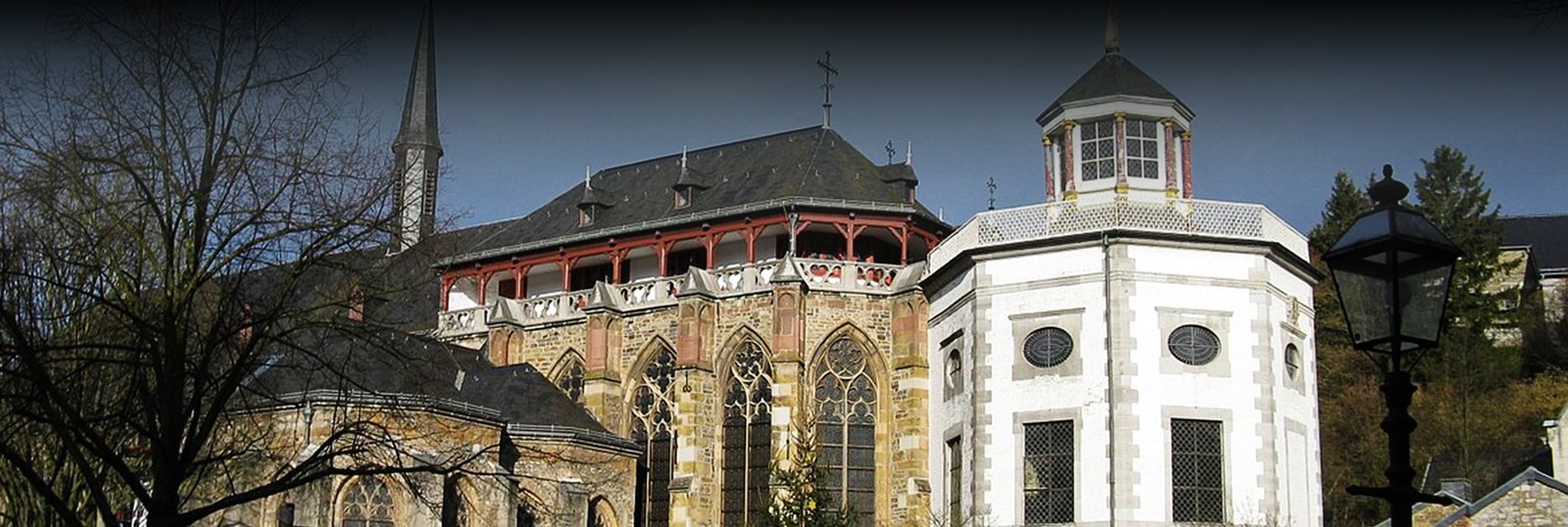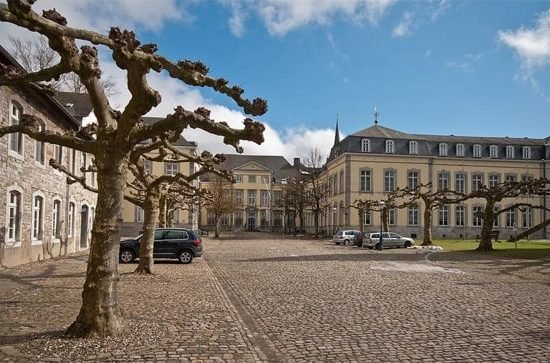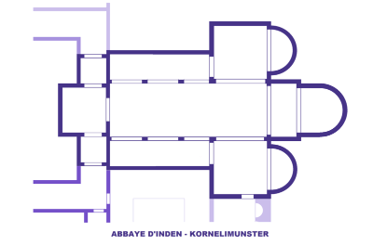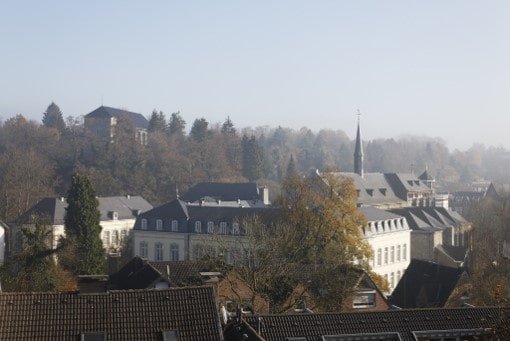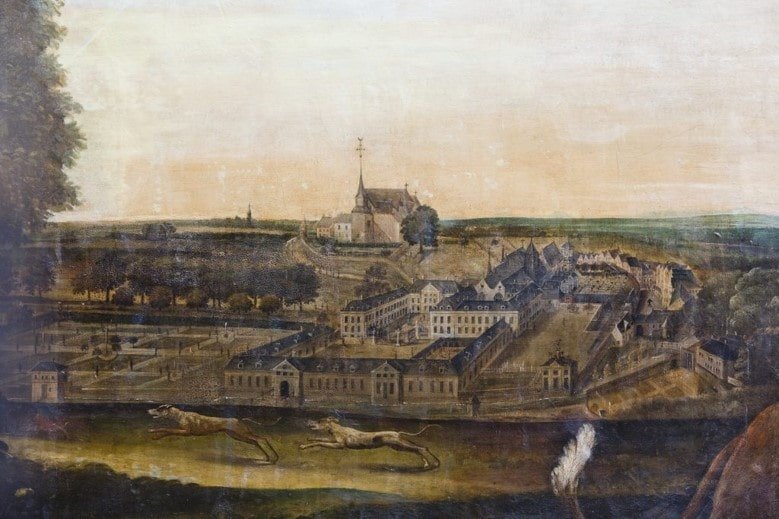Kornelimünster Abbey
per person
The Kornelimünster Abbey was founded in 814 on the Inde River by Benedict of Aniane (750–821), at the suggestion of Louis the Pious, son and successor of Charlemagne. The cloister was originally called Redeemer Cloister on the Inde (Erlöserkloster an der Inde). In the middle of the 9th century, the cloister was given imperial immediacy and subsequently came into possession of a large swath of area surrounding the church. In 875, certain reliquaries were exchanged for one belonging to the martyr saint, Pope Cornelius (who died in 253). The cloister thereafter became known as Sancti Cornelii ad Indam (St Cornelius on the Inde), and then Kornelimünster. Today, the official title of the abbey is the Abbey of St Benedict of Aniane and Pope Cornelius.
In 1500 the abbey became part of the Lower Rhenish–Westphalian Circle, and in 1802, the area fell to the French. Along with other abbeys in French controlled areas, the abbey at Kornelimünster was abolished and the monks were forced to leave. During this time, the community of Kornelimünster came under administration of the French, under the Mairie system. In 1815 Prussia came into possession of Kornelimünster and was subsequently administered as part of the old district of Aachen (before the administrative restructuring of 1972). Benedictine monks returned to the Kornelimünster Abbey in 1906 to found the New Benedictine Kornelimünster Abbey. The St Cornelius Church of the former abbey is today the parish church of the community and is the oldest abbey building still used in the state of North Rhine-Westphalia.
During World War II U.S. forces reached the area south of Aachen in the fall of 1944. On 19 September Kornelimünster was captured without major damage. The first summary court in Germany during World War II opened in Kornelimünster late in September. In 1971 Kornelimünster joined together with other area communities such as Breinig, Mulartshütte, Roetgen, Venwegen and Walheim to argue in favor of creating a Münsterland district. Instead, on 1 January 1972, the area was divided as follows: the Kornelimünster and Walheim communities were combined into the Kornelimünster/Walheim district of Aachen, while Breinig and Venwegen went to Stolberg. The remaining communities of Mulartshütte, Rott and Roetgen were combined into the Roetgen district.
FORMAL ANALYSIS
The founder of Kornelimünster Abbey, Benedict of Aniane (750-821), came from the Visigoth nobility of southern France, was educated at the court of King Pippin, turned to monastic life after a short period in royal service and founded a monastery around 779 in Aniane near Montpellier. Through this monastery, Benedict of Aniane gained great influence with Louis the Pious, son and successor of Charlemagne as Emperor of the Frankish Empire. Benedict followed Ludwig to the court of Aachen, where he acted as an adviser to the Aachen reform synods (816-818). The monastery of Kornelimünster, which was founded at this time and was richly endowed, was intended to serve as a model for the renewal of monasticism and monasticism (schola monachorum) in the Frankish Empire, based on the Regula Benedicti, the rule of Benedict of Nursia, in order to complement those that had developed over the centuries to unify very different monastic traditions.
However, Benedict’s reforms also provoked resistance, which increased after his death and finally led to Benedict’s veneration at best in his southern French homeland being limited. Kornelimünster could therefore not maintain its importance after the death of the monastery founder and remained a rather modest monastery.
Emperor Ludwig the Pious had given Benedict of Aniane three relics that originally came from the relic treasure of the Palatine Chapel in Aachen: the apron (linteum Domini), which according to tradition Jesus had tied on to wash the disciples’ feet at the Last Supper, a shroud (sindon munda ), which according to ancient tradition was used at the burial and on which the body of Jesus is said to have been laid in the tomb, and the veil (sudarium Domini), which is said to be the cloth that covered the head of Jesus and which Peter and John found folded in the empty tomb of Jesus. In 875, however, the shroud was divided because Charles the Bald needed one half of the shroud to found a monastery in Compiègne. As compensation, the monastery received the skull relic of Pope Saint Cornelius and that of Saint Cyprianus. The veneration of Pope Cornelius († 253) led to a change in patronage and name from the 12th century: the monastery was given the name Monasterium Sancti Cornelii ad Indam, from which the current place name Kornelimünster is derived.
These reliquary treasures ultimately led to Kornelimünster becoming the destination of a special pilgrimage from the 14th century, the so-called Kornelimünster sanctuary journey, which in the Middle Ages, together with the pilgrimage to Aachen, was as important as the pilgrimages to Rome, Jerusalem or Santiago de Compostela.
The first monastery church, consecrated in 817, was a small three-nave basilica. It was destroyed at the end of the 9th century. After the rebuilt monastery was destroyed again in 1310, a large Gothic church was built in the form of a five-aisled hall. The two southern naves were designed as a pilgrimage church. The other areas of the church were separated from it and reserved for the members of the monastery. The Propsteikirche was thus a monastery and pilgrimage church at the same time. Due to the growing number of pilgrims coming to Kornelimünster, the abbey church was enlarged several times in the 15th and 16th centuries. The abbey church, which essentially dates from the Gothic period, was expanded in 1706 on the east side to include the octagonal Cornelius Chapel.
Between 1792 and 1794 the monks fled several times from the invading French revolutionary troops. In 1802, like all monasteries in the Rhineland, the abbey was finally dissolved by Napoleon. This resolution was implemented for the Kornelimünster Imperial Abbey with its lands, furniture and other values in the Procès Verbal of August 8, 1802, a settlement protocol. The goods had to be handed over and the monks had to leave the abbey. The abbey church was given to the Catholic community as a parish church and the sanctuaries/relics were given to the parish in 1804. As such, it is now a Roman Catholic parish church and a pilgrimage church in the diocese of Aachen under the name of St. Kornelius.
In 1906 the Benedictines came to Kornelimünster again. Since the old abbey buildings belonged to the state and were used for other purposes, they founded the New Benedictine Abbey Kornelimünster at the western end of Kornelimünster, which, however, is not the legal successor to the old imperial abbey.
After the Second World War, the state of North Rhine-Westphalia became the owner of the former Kornelimünster Imperial Abbey. Since the abbey church was left to the Catholic community as a parish church in 1802, the state is only the owner of the baroque five-winged abbey building with two inner courtyards.
Up until the 1970s, war damage was repaired and the stucco work and ceiling paintings that were still in the middle wing were restored with state funds. Since 1976, this representative building has housed the Art from North Rhine-Westphalia institution – funding purchases since 1945, since 2015 the Kunsthaus Nordrhein-Westfalen Kornelimünster. The collection of modern art from NRW is shown in the abbot’s residence and in the north wing of the convent. The permanent collection includes a selection of such works of art, which have been acquired since the state was founded by the then Ministry of Education and its successor by the culture department of the Ministry for Family, Children, Youth, Culture and Sport of the State of North Rhine-Westphalia for cultural promotion. Changing exhibitions have also been held in the facility since 1996. Admission is free.
FLORIAN HARTMANN
- INDEN-KORNELIMÜNSTER ABBEY© FOT. Alupus, https://www.kuladig.de/Objektansicht/O-13598-20110718-25
- PLAN OF THE CAROLINGIAN CHURCH© J. CHANCEREL, https://es.m.wikipedia.org/wiki/Archivo:IndenPlan.png
- WALL PAINTING OF A HUNTING SCENE IN FRONT OF KORNELIMÜNSTER ABBEY, 18 TH CENTURY© FOT. Bildarchiv Monheim, https://www.kunsthaus.nrw/wp-content/uploads/2018 /06/KNRW-Kunsthaus-NRW-c-Foto-Bildarchiv-Monheim-8-1024×683.jpg
- PROVOST CHURCH ST. KORNELIUS© FOT. Andreas Toerl, https://commons.wikimedia.org/ wiki/File:Eifelsteig_Kornelimünster.JPG
- VIEW FROM THE EAST OF THE ABBEY CHURCH WITH THE KORNELIUS CHAPEL© FOT. Bildarchiv Monheim, https://www.kunsthaus.nrw/ wp-content/uploads/2015/12/76383-1024×710.jpg
- VIEW OF THE FORMER REICH ABBEY KORNELIMÜNSTER© FOT. https://www.baukunst-nrw.de/en/projects/Former- Reich-Abbey-Kornelimuenster–659.htm
- VIEW OF THE FORMER MONASTERY COMPLEX FROM THE SOUTH-WEST© FOT. Bildarchiv Monheim, https://www.kunsthaus.nrw/wp-content/ uploads/2015/11/KNRW-Kunsthaus-NRW-c-Foto-Bildarchiv-Monheim-3-1024×683.jpg
Información de la localidad
Kornelimünster Abbey
| Other monuments and places to visit | New Benedictine Abbey Kornelimünster St. Kornelius (five-aisled church in the Gothic style; originally monastery church) |
| Natural Heritage | Statement “Picturesque Landscape” (1969) |
| Historical Recreations | |
| Festivals of Tourist Interest | Open air carnival session Eifelsteig hiking trail |
| Fairs | Historical fair Christmas Market |
| Tourist Office | No |
| Specialized Guides | Yes |
| Guided visits | Yes |
| Accommodations | Yes |
| Restaurants | Restaurant Sankt Benedikt Restaurant Bahnhofsvision Restaurant Im Krebsloch Café Restaurant Napoleon |
| Craft | |
| Bibliography | |
| Videos | |
| Website |
| Monument or place to visit | Kornelimünster Abbey |
| Style | Gothic church and baroque monastery building |
| Type | |
| Epoch | 814 - 1802 |
| State of conservation | Destroyed and rebuilt several times |
| Mailing address | Abteigarten 6 – 50276 Aachen, Germany |
| Coordinates GPS | O 50,7295°N: 6,1681°O |
| Property, dependency | State of North Rhine-Westphalia |
| Possibility of visits by the general public or only specialists | General public visits |
| Conservation needs | The entire building complex has been renovated piecemeal since the early 1990s |
| Visiting hours and conditions | Opening hours of the Kunsthaus NRW Kornelimünster: Thursday to Saturday 12 p.m. to 5 p.m Sundays and public holidays 11 a.m. to 5 p.m |
| Ticket amount | Free |
| Research work in progress | The state of North Rhine-Westphalia has started to restore a number of baroque wall and ceiling paintings. First investigations have uncovered original paintings from the 18th century under tinted varnish, overpainting and soot. |
| Accessibility | Accessibility only possible to a limited extent. The upper floor with the collection presentation can only be reached via stairs. |
| Signaling if it is registered on the route | |
| Bibliography | Alfred Bruns: Reichsabtei Kornelimünster. In: Gerhard Taddey (Hrsg.): Lexikon der deutschen Geschichte. Personen, Ereignisse, Institutionen. Von der Zeitwende bis zum Ausgang des 2. Weltkrieges. 2., überarbeitete Auflage. Kröner, Stuttgart 1983, ISBN 3-520-80002-0, S. 692. Paul Fabianek: Folgen der Säkularisierung für die Klöster im Rheinland. Am Beispiel der Klöster Schwarzenbroich und Kornelimünster. BoD, Norderstedt 2012, ISBN 978-3-8482-1795-3. Jens Nürnberger: Die Rückkehr der Benediktiner in das Erzbistum Köln nach Säkularisation und Kulturkampf. Die neue Benediktinerabtei in Kornelimünster (= Veröffentlichungen des Bischöflichen Diözesanarchivs Aachen 51). Aachen 2014, ISBN 978-3-943748-20-8. Lothar Stresius: Kornelimünster. Benediktinerabtei – Propsteikirche – Ort. Schnell & Steiner, Regensburg 2014, ISBN 978-3-7954-2719-1. |
| Videos | kunsthaus.nrw |
| Information websites | kunsthaus.nrw wikipedia.org kuladig.de |
| Location | Kornelimünster, Aachen, Germany |


